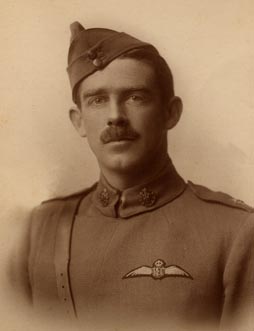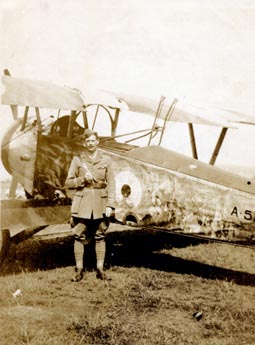
Capt Lionel Hicks
RFC 1915-1918![]()
|
|
Captain Lionel Hicks RFC 1883-1923 Lionel Hicks travelled from Argentina as a volunteer to join the British Army during the First World War. He was accepted for the Royal Flying Corps on passing his Royal Aeronautical Club certificate (no. 2126) on 2 December 1915. The London Gazette records his appointment as a Flying Officer, Special Reserve. |
On 12 March 1916, following RFC flying training, Lt Hicks was appointed as a Flying Officer to No. 22 Squadron based at Gosport. The Squadron was preparing to move to France on operational deployment with new FE2B two seat fighters. He flew with the other 22 Sqn pilots to France on 28 March accompanied by aircraft mechanics. The Squadron gunner/observers travelled by sea with the rest of the personnel and equipment. The squadron's spare pilot was Cecil Lewis who recorded a similar departure of 25 Sqn from Gosport in his book "Sagittarius Rising":
The machines lined up by Flights in front of the sheds, three rows of four each. ...The streamers fluttered from the rudders of the Flight-Commanders. The Lewis guns stood cocked up on thier mountings. The pilots and observers, muffled up in their leather coats, stumped about in the sheepskin boots, strapping up their haversacks, looking over their machines, polishing their goggles. They collected round the Major for final instructions, consulted their maps, and went off, pulling on flying caps and mufflers, climbed into their cockpits, settled down and strapped themselves in. The mechanics kicked the chocks more firmly against the wheels and sucked in the engines. Contact! The pilots spun their Starting magnetos, and one by one the engines sprang to life. Three minutes to warm them up, and then a heavy roar, which rose and fell as pilot after pilot ran up his engine, tested his magnetos, and then, satisfied, throttled down again. At last they were all ready ... The Major dropped his hand and A Flight Flight-Commander opened his engine up, turned, and taxied away down the aerodrome. The others followed in single file, and one by one they headed to the wind, pushed their throttles open, rose, ... and sailed up towards the sheds.
... they came hurtling up, their goggled pilots and observers leaning down to wave a last farewell before they passed in a deafening flash of speed and smoke fifty feet overhead.
Once in the air, the squadron took formation. The three flights, each a diamond, wheeled, a moving arrow head (A Flight leading, B and C to right and left) ... passed majestically away in the sunlight, growing smaller and smaller...
A month later on 20 March 1918 (sic)... the scene repeated itself, for another FE squadron, No 22, left for France. [Lewis says that he left the day prior to departure as spare pilot with the rest of the squadron personnel. In the event the aircraft departed on 28 March, the ground element being in medical isolation for a week or so.]

Lt.s Perry, Hicks and Taylor in front of 22 Sqn FE2b "River Plate"
|
Cecil Lewis in "Sagittarius Rising" describes the FE2b as follows: The FE2b was a pusher, a development of the Vickers Fighter, made by the Royal Aircraft Factory. It had a 160 hp Beardmore engine and an Oleo telescopic undercarriage. This, in the air, hung down like a pair of stilts on wheels; but when you touched the ground, it shut up, taking the weight and the shock of uneven landings and settling the machine on to the ground in a long comfortable rumble. It was a fine machine, slow, but very sturdy, and carried a pilot, and an observer before him, in a boot which stuck out in front of the machine. Forward, therefore, it had a very fine arc of fire and, attacked head on, was extremely formidable. Attacked from the rear, it was necessary for the pilot to stand up in his seat, hold the stick with his knees and use his own gun which fired backwards over the top plane - not an easy job... |
22 Sqn under command of Major A B Martyn, was based first at Vert Galand and from 16 April 1916 at Bertangles (near Amiens). The Bertangles field was shared with 24 Sqn (DH2’s) commanded by Maj Lanoe Hawker VC. The initial work of the squadron was reconnaissance and photography. The Squadron history (by W J F Harvey) describes their initiation to war as gentle and gradual in the three months before the Somme offensive. Between 15 and 18 May, the squadron photographed 20 miles of the enemy's trench system between Gommecourt, south of Arras, and Curlu on the River Somme in front of the Fourth Army. This work was part of the preparatory action for the Somme offensive on 1 July 1916.
Lt Hicks suffered problems with his health that led to restrictions on his flying. He returned to Home Establishment on 19 May 1916 and was appointed in July to No 3 Reserve Squadron at Shoreham as an instructor. No 3 RS was responsible basic flying training which was being expanded rapidly by the RFC to meet the increasing Squadron establishment in France.

Maurice Farman Shorthorn trainer at 3 RS Shoreham
Lt Hicks' record shows that he was under medical restriction not to fly above 4,000 ft. This would not have been a problem as the squadron operated the lumbering Maurice Farman Shorthorn machines, then (with the MF Longhorn) the main training workhorses of the RFC. The training was generally conducted below 1,000 ft in benign conditions (with windspeed less than 5 mph) in early morning or evening. The Shorthorn was an awkward trainer, in addition to availability being limited by weather conditions, there was only limited dual control for instruction. Michael Skeet describes trainee pilots learning: "by resting hands and feet lightly on the controls while the instructor flew the plane, a cadet attempted to absorb what the instructor was doing while observing the results of these actions on the machine. There was almost no communication between instructor and pupil in the air. One instructor, Lt. Russell, sometimes handed notes to a pupil in the front seat". Training flights were of short duration, often 5-15 minutes, within sight of the airfield, with emphasis on landings and take-offs.
|
|
He was appointed a Flight Commander (Captain) in March 1917 and continued to serve as an instructor with 3 RS (?and its successor unit 21 TDS Driffield) until the end of the war. Major F W Smith joined 3 RS as commanding officer in March before moving on to command 62 Squadron in October.
Left, Captain Hicks in front of one of his Flight's MF Shorthorns. |
|
The Squadron appears to have received Avro 504 trainers probably from late 1917 and possibly some Nieuports.
Right, Captain Hicks beside a Nieuport Type 12 (transferred from RNAS, serials A5183-5202). |
|
|
Background Sources: “Pi in the Sky” The history of 22 Sqn during the 1914-18 War by Capt W J F Harvey "Sagittarius Rising" by Cecil Lewis "RFC Pilot Training" by Michael Skeet, article on www.theaerodrome.com forum "The Airman's War 1914-18" by Peter Liddle |
Photos Copyright © Hicks family and airwar1.org.uk


